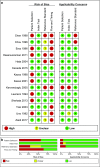Diagnostic accuracy of preoperative ultrasonography in predicting contralateral inguinal hernia in children: a systematic review and meta-analysis
- PMID: 30054793
- PMCID: PMC6302883
- DOI: 10.1007/s00330-018-5625-6
Diagnostic accuracy of preoperative ultrasonography in predicting contralateral inguinal hernia in children: a systematic review and meta-analysis
Abstract
Objectives: The incidence of children developing metachronous contralateral inguinal hernia (MCIH) is 7-15%. Contralateral groin exploration during unilateral hernia repair can prevent MCIH development and subsequent second surgery and anaesthesia. Preoperative ultrasonography is a less invasive strategy and potentially able to detect contralateral patent processus vaginalis (CPPV) prior to MCIH development.
Methods: We queried MEDLINE, Embase and Cochrane library to identify studies regarding children aged < 18 years diagnosed with unilateral inguinal hernia without clinical signs of contralateral hernia, who underwent preoperative ultrasonography of the contralateral groin. We assessed heterogeneity and used a random-effects model to obtain pooled estimates of sensitivity, specificity and area under the receiver operating characteristic curve (AUC).
Results: Fourteen studies (2120 patients) were included, seven (1013 patients) in the meta-analysis. In studies using surgical exploration as reference test (n = 4, 494 patients), pooled sensitivity and specificity were 93% and 88% respectively. In studies using contralateral exploration as reference test following positive and clinical follow-up after negative ultrasonographic test results (n = 3, 519 patients), pooled sensitivity was 86% and specificity 98%. The AUC (0.984) shows high diagnostic accuracy of preoperative ultrasonography for detecting CPPV, although diagnostic ultrasonographic criteria largely differ and large heterogeneity exists. Reported inguinal canal diameters in children with CPPV were 2.70 ± 1.17 mm, 6.8 ± 1.3 mm and 9.0 ± 1.9 mm.
Conclusion: Diagnostic accuracy of preoperative ultrasonography to detect CPPV seems promising, though may result in an overestimation of MCIH prevalence, since CPPV does not invariably lead to MCIH. Unequivocal ultrasonographic criteria are mandatory for proper diagnosis of CPPV and subsequent prediction of MCIH.
Key points: • Diagnostic accuracy of preoperative ultrasonography for detection of CPPV in children with unilateral inguinal hernia is high. • Preoperative ultrasonographic evaluation of the contralateral groin assumedly results in an overestimation of MCIH prevalence. • Unequivocal ultrasonographic criteria are mandatory for proper diagnosis of CPPV and risk factor identification is needed to predict whether CPPV develops into clinically apparent MCIH.
Keywords: Child; Hernia, inguinal; Ultrasonography.
Conflict of interest statement
Guarantor
The scientific guarantor of this publication is JPM Derikx, MD PhD.
Conflict of interest
The authors of this manuscript declare no relationships with any companies whose products or services may be related to the subject matter of the article.
Statistics and biometry
One of the authors, Professor JWR Twisk, has significant statistical expertise.
Informed consent
Written informed consent was not required for this study because it comprises a systematic review of published literature.
Ethical approval
Institutional review board approval was not required because it comprises a systematic review of published literature.
Methodology
• Diagnostic accuracy test systematic review and meta-analysis
Figures




References
Publication types
MeSH terms
LinkOut - more resources
Full Text Sources
Other Literature Sources

